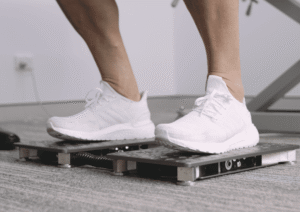We’re going to take you through the most common forms of pain relief injections, how they work to reduce discomfort, which ones are suitable for certain conditions and how pain relief injections can be used alongside sports therapy.
What is the most common injection for pain relief?
The most common injection for pain relief is Corticosteroids (CSI), an anti-inflammatory injection that reduces swelling, pain and stiffness. They’re often used to treat joint arthritis and soft tissue pain, and/or tendinopathy.
Corticosteroids are administered directly to the problem area to reduce swelling and relieve pain. Their positive effects tend to last anywhere from a few weeks to a few months, based on your individual reaction to them. Positively, if used alongside effective treatment and rehabilitation methods, corticosteroids can help to ease pain until the core issue is resolved.
Another common type of pain relief injection is Ostenil, a substance containing sodium hyaluronate, which helps to block pain receptors and hinder inflammation. To determine which type of injection would be most beneficial for you, speak to a professional qualified in injection therapy, so they can discuss your symptoms with you and decide on the best course of action.
How injections can provide pain relief

Primarily, injections provide pain relief by reducing inflammation in targeted areas. Effectively, injected hormones such as corticosteroids mimic the naturally occurring hormones in your body to suppress the response of your immune system, and lower inflammation.
Inflammation is an automatic response from our body, which is designed to aid in the recovery of tissue damage and other similar problems. However, this response can sometimes be counterproductive, and inhibit us from getting us to the roots of your pain easily.
Often, an injection will provide pain relief both directly and by allowing us to decipher which structures are causing you pain. If we are able to outline areas which pain is stemming from through pain relief injections, we’re more likely to find the root cause of muscle/tendon related issues and implement other massage techniques and injury rehabilitation strategies to resolve them.
The best types of injections for pain relief
The best injections for pain relief are:
Best injection for lower back pain
For lower back pain, Epidural Steroid Injections (ESIs) are commonly used and can be very effective. Much lower back pain, such as sciatica, is caused by inflamed muscles putting pressure on nerves. Such injections can reduce swelling in targeting areas, thus easing the cause of pain.
In most cases, lower back pain is best dealt with through a range of massage techniques, as well as injection therapy. Normally, injection therapy is highly beneficial at easing pain, but is unlikely to solve the root causes of it.
How pain relief injections work with sports therapy

Pain relief injections can be used effectively in unison with sports therapy by reducing pain and inflammation around the troublesome area, which allows more effective work to be done using massage techniques and exercise plans to correct the core issue.
Sometimes, inflammation as a result of injury or a strain can cause a lot of pain, and make it hard to effectively move and manipulate joints or tendons in beneficial ways. Using pain relief injections to ease this pain allows us to slowly and carefully help you regain movements through certain massage techniques such as:
At Injury Mechanics, we adopt a holistic approach to treatment, understanding your issues as well as your goals, before advising and guiding you through the best course of action.
Before proceeding with injection therapy, or any other form of therapy for pain relief, we’d always make sure it was the right course of action for you, and well aligned with your goals.




